1876 United States presidential election
The 1876 United States presidential election was the 23rd quadrennial presidential election, held on Tuesday, November 7, 1876, in which Republican nominee Rutherford B. Hayes faced Democrat Samuel J. Tilden. It was one of the most contentious and controversial presidential elections in American history, and gave rise to the Compromise of 1877 by which the Democrats conceded the election to Hayes in return for an end to Reconstruction and the withdrawal of federal troops from the South. After a controversial post-election process, Hayes was declared the winner.[2]
| |||||||||||||||||||||||||||||
369 members of the Electoral College 185 electoral votes needed to win | |||||||||||||||||||||||||||||
|---|---|---|---|---|---|---|---|---|---|---|---|---|---|---|---|---|---|---|---|---|---|---|---|---|---|---|---|---|---|
| Turnout | 81.8%[1] | ||||||||||||||||||||||||||||
| |||||||||||||||||||||||||||||
  Presidential election results map. Red denotes states won by Hayes/Wheeler, blue denotes those won by Tilden/Hendricks. Numbers indicate the number of electoral votes allotted to each state. | |||||||||||||||||||||||||||||
| |||||||||||||||||||||||||||||
After President Ulysses S. Grant declined to seek a third term despite previously being expected to do so, Congressman James G. Blaine emerged as the front-runner for the Republican nomination. However, Blaine was unable to win a majority at the 1876 Republican National Convention, which settled on Governor Hayes of Ohio as a compromise candidate. The 1876 Democratic National Convention nominated Governor Tilden of New York on the second ballot.
The results of the election remain among the most disputed ever. Although it is not disputed that Tilden outpolled Hayes in the popular vote, after a first count of votes, Tilden had won 184 electoral votes to Hayes' 165, with 20 votes from four states unresolved: in Florida, Louisiana, and South Carolina, each party reported its candidate had won the state, while in Oregon, one elector was replaced after being declared illegal for being an "elected or appointed official". The question of who should have been awarded these electoral votes is the source of the continued controversy.
An informal deal was struck to resolve the dispute: the Compromise of 1877, which awarded all 20 electoral votes to Hayes; in return for the Democrats' acquiescence to Hayes' election, the Republicans agreed to withdraw federal troops from the South, ending Reconstruction. The Compromise in effect ceded power in the Southern states to the Democratic Redeemers, who proceeded to disenfranchise black voters thereafter.
The 1876 election is the second of five presidential elections in which the person who won the most popular votes did not win the election, but the only such election in which the popular vote winner received a majority (rather than a plurality) of the popular vote. To date, it remains the election that recorded the smallest electoral vote victory (185–184), and the election that yielded the highest voter turnout of the eligible voting age population in American history, at 81.8%.[1][3] Despite not becoming president, Tilden was the first Democratic presidential nominee since James Buchanan in 1856 to win the popular vote and the first since Franklin Pierce in 1852 to do so in an outright majority (In fact, Tilden received a slightly higher percentage than Pierce in 1852, despite the fact that Pierce won in a landslide).
Nominations
Republican Party nomination
| Rutherford B. Hayes | William A. Wheeler | ||||||||||||||||||||||||||||
|---|---|---|---|---|---|---|---|---|---|---|---|---|---|---|---|---|---|---|---|---|---|---|---|---|---|---|---|---|---|
| for President | for Vice President | ||||||||||||||||||||||||||||
 |
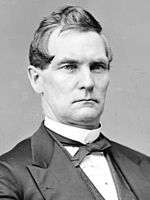 | ||||||||||||||||||||||||||||
| 29th & 32nd Governor of Ohio (1868–1872 & 1876–1877) |
U.S. Representative for New York's 19th (1861–1863 and 1869–1877) | ||||||||||||||||||||||||||||
| Campaign | |||||||||||||||||||||||||||||
 Governor Rutherford B. Hayes of Ohio
Governor Rutherford B. Hayes of Ohio
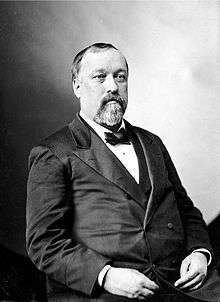 Secretary of the Treasury Benjamin Bristow
Secretary of the Treasury Benjamin Bristow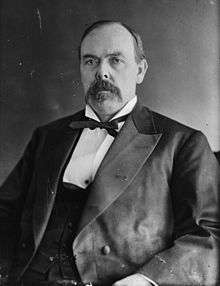 Senator Oliver P. Morton from Indiana
Senator Oliver P. Morton from Indiana Senator Roscoe Conkling from New York
Senator Roscoe Conkling from New York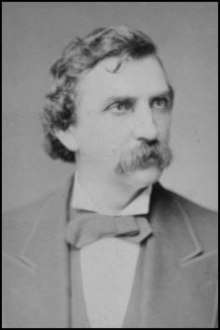 Governor John F. Hartranft of Pennsylvania
Governor John F. Hartranft of Pennsylvania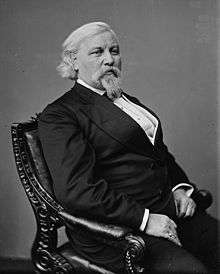
 Ambassador Elihu B. Washburne from Illinois
Ambassador Elihu B. Washburne from Illinois



It was widely assumed during the year 1875 that incumbent President Ulysses S. Grant would run for a third term as president in spite of the poor economic conditions, the numerous political scandals that had developed since he assumed office in 1869, and a long-standing tradition set by the first president, George Washington, not to stay in office longer than two terms. Grant's inner circle advised him to go for a third term and he almost did, but the House, by a sweeping 233 to 18 vote, passed a resolution declaring that the two-term tradition was to prevent a dictatorship. Late in the year, President Grant ruled himself out of running in 1876. He instead tried to persuade his Secretary of State, Hamilton Fish to run for the presidency, but the 67-year-old Fish declined, believing himself too old for the role. Grant nonetheless sent a letter to the convention imploring them to nominate Fish, but the letter was misplaced and never read out to the convention, and Fish later confirmed that he would have declined the nomination even had he been offered it.
When the Sixth Republican National Convention assembled in Cincinnati, Ohio, on June 14, 1876, it appeared that James G. Blaine would be the nominee. On the first ballot, Blaine was just 100 votes short of a majority. His vote began to slide after the second ballot, however, as many Republicans feared that Blaine could not win the general election. Anti-Blaine delegates could not agree on a candidate until Blaine's total rose to 41% on the sixth ballot. Leaders of the reform Republicans met privately and considered alternatives. They chose Ohio's reform governor, Rutherford B. Hayes, who had been gradually building support during the convention until he finished second on the sixth ballot. On the seventh ballot, Hayes was nominated with 384 votes to 351 for Blaine and 21 for Benjamin Bristow. William A. Wheeler was nominated for vice-president by a much larger margin (366–89) over his chief rival, Frederick Theodore Frelinghuysen, who later served as a member of the electoral commission that awarded the election to Hayes.
| Presidential Ballot | |||||||||||||||||||||||
| Ballot | 1st | 2nd | 3rd | 4th | 5th | 6th | 7th | ||||||||||||||||
|---|---|---|---|---|---|---|---|---|---|---|---|---|---|---|---|---|---|---|---|---|---|---|---|
| James G. Blaine | 285 | 296 | 293 | 292 | 286 | 308 | 351 | ||||||||||||||||
| Oliver P. Morton | 124 | 120 | 113 | 108 | 95 | 85 | 0 | ||||||||||||||||
| Benjamin Bristow | 113 | 114 | 121 | 126 | 114 | 111 | 21 | ||||||||||||||||
| Roscoe Conkling | 99 | 93 | 90 | 84 | 82 | 81 | 0 | ||||||||||||||||
| Rutherford B. Hayes | 61 | 64 | 67 | 68 | 104 | 113 | 384 | ||||||||||||||||
| John F. Hartranft | 58 | 63 | 68 | 71 | 69 | 50 | 0 | ||||||||||||||||
| Marshall Jewell | 11 | 0 | 0 | 0 | 0 | 0 | 0 | ||||||||||||||||
| William A. Wheeler | 3 | 3 | 2 | 2 | 2 | 2 | 0 | ||||||||||||||||
| Elihu B. Washburne | 0 | 1 | 1 | 3 | 3 | 4 | 0 | ||||||||||||||||
 1st Presidential Ballot
1st Presidential Ballot 2nd Presidential Ballot
2nd Presidential Ballot 3rd Presidential Ballot
3rd Presidential Ballot 4th Presidential Ballot
4th Presidential Ballot 5th Presidential Ballot
5th Presidential Ballot 6th Presidential Ballot
6th Presidential Ballot 7th Presidential Ballot
7th Presidential Ballot
| Vice Presidential Ballot [6] | |||||||||||||||||||||||
| Ballot | 1st Partial | ||||||||||||||||||||||
|---|---|---|---|---|---|---|---|---|---|---|---|---|---|---|---|---|---|---|---|---|---|---|---|
| William A. Wheeler | 366 | ||||||||||||||||||||||
| Frederick T. Frelinghuysen | 89 | ||||||||||||||||||||||
| Marshall Jewell | 86 | ||||||||||||||||||||||
| Stewart L. Woodford | 70 | ||||||||||||||||||||||
| Joseph R. Hawley | 25 | ||||||||||||||||||||||
 Recorded Vice Presidential Ballot
Recorded Vice Presidential Ballot
Democratic Party nomination
| Samuel J. Tilden | Thomas A. Hendricks | ||||||||||||||||||||||||||||
|---|---|---|---|---|---|---|---|---|---|---|---|---|---|---|---|---|---|---|---|---|---|---|---|---|---|---|---|---|---|
| for President | for Vice President | ||||||||||||||||||||||||||||
 |
 | ||||||||||||||||||||||||||||
| 25th Governor of New York (1875–1876) |
16th Governor of Indiana (1873–1877) | ||||||||||||||||||||||||||||
| Campaign | |||||||||||||||||||||||||||||
Democratic candidates:
- Samuel J. Tilden, governor of New York
- Thomas A. Hendricks, governor of Indiana
- Winfield Scott Hancock, United States Army major general from Pennsylvania
- William Allen, former governor of Ohio
- Thomas F. Bayard, U.S. senator from Delaware
- Joel Parker, former governor of New Jersey


 Major General Winfield Scott Hancock from Pennsylvania
Major General Winfield Scott Hancock from Pennsylvania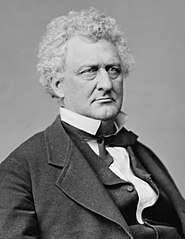 William Allen from Ohio
William Allen from Ohio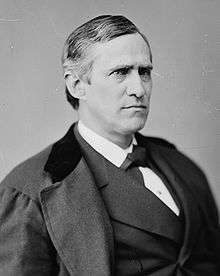
 Joel Parker from New Jersey
Joel Parker from New Jersey

The 12th Democratic National Convention assembled in St. Louis, Missouri, in June 1876, the first political convention held by one of the major American parties west of the Mississippi River. Five thousand people jammed the auditorium in St. Louis with hopes for the Democratic Party's first presidential victory in 20 years. The platform called for immediate and sweeping reforms in response to the scandals that had plagued the Grant administration. Tilden won more than 400 votes on the first ballot and the nomination by a landslide on the second.
Tilden defeated Thomas A. Hendricks, Winfield Scott Hancock, William Allen, Thomas F. Bayard, and Joel Parker for the presidential nomination. Tilden overcame strong opposition from "Honest John" Kelly, the leader of New York's Tammany Hall, to obtain the nomination. Thomas Hendricks was nominated for vice-president, since he was the only person put forward for the position.
The Democratic platform pledged to replace the corruption of the Grant administration with honest, efficient government and to end "the rapacity of carpetbag tyrannies" in the South. It also called for treaty protection for naturalized United States citizens visiting their homelands, restrictions on Asian immigration, tariff reform, and opposition to land grants for railroads.[7] It has been claimed that the voting Democrats received Tilden's nomination with more enthusiasm than any leader since Andrew Jackson.[8]
| Presidential Ballot | ||||||
| 1st Before Shifts | 1st After Shifts | 2nd Before Shifts | 2nd After Shifts | Unanimous | ||
|---|---|---|---|---|---|---|
| Samuel J. Tilden | 400.5 | 416.5 | 535 | 517 | 738 | |
| Thomas A. Hendricks | 139.5 | 139.5 | 85 | 87 | ||
| Winfield Scott Hancock | 75 | 75 | 58 | 58 | ||
| William Allen | 54 | 54 | 54 | 54 | ||
| Thomas F. Bayard | 33 | 33 | 4 | 4 | ||
| Joel Parker | 18 | 18 | 0 | 18 | ||
| James Broadhead | 16 | 0 | 0 | 0 | ||
| Allen G. Thurman | 2 | 2 | 2 | 0 | ||

1st Presidential Ballot
Before Shifts
1st Presidential Ballot
After Shifts
2nd Presidential Ballot
Before Shifts
2nd Presidential Ballot
After Shifts
Source: Official proceedings of the National Democratic convention, held in St. Louis, Mo., June 27th, 28th and 29th, 1876. (September 3, 2012).
| Vice Presidential Ballot | |
| 1st | |
|---|---|
| Thomas A. Hendricks | 730 |
| Blank | 8 |
Source: Official proceedings of the National Democratic convention, held in St. Louis, Mo., June 27th, 28th and 29th, 1876 (September 3, 2012).
Greenback Party nomination
Greenback candidates:
- Peter Cooper, U.S. philanthropist from New York
- Andrew Curtin, former governor of Pennsylvania
- William Allen, former governor of Ohio
- Alexander Campbell, U.S. representative from Illinois
Candidates gallery

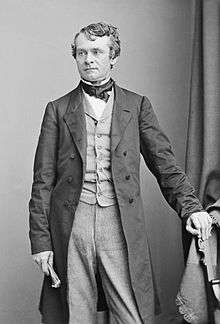 Andrew Curtin from Pennsylvania
Andrew Curtin from Pennsylvania William Allen from Ohio
William Allen from Ohio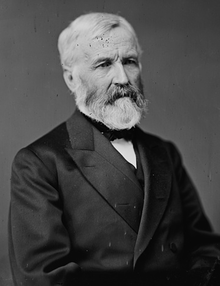
The Greenback Party had been organized by agricultural interests in Indianapolis, Indiana, in 1874 to urge the federal government to inflate the economy through the mass issuance of paper money called greenbacks. Its first national nominating convention was held in Indianapolis in the spring of 1876. Peter Cooper was nominated for president with 352 votes to 119 for three other contenders. The convention nominated Anti-Monopolist Senator Newton Booth of California for Vice-President; after Booth declined to run, the national committee chose Samuel Fenton Cary as his replacement on the ticket.[9]
| Presidential Ballot | |
| Ballot | 1st |
|---|---|
| Peter Cooper | 352 |
| Andrew Curtin | 58 |
| William Allen | 31 |
| Alexander Campbell | 30 |
Source: US President – G Convention. Our Campaigns. (February 10, 2012).
Prohibition Party nomination
The Prohibition Party, in its second national convention in Cleveland, nominated Green Clay Smith as its presidential candidate and Gideon T. Stewart as its vice-presidential candidate.
American National Party nomination
This small political party used several different names, often with different names in different states. It was a continuation of the Anti-Masonic Party that met in 1872 and nominated Charles Francis Adams for president. When Adams declined to run, the party did not contest the 1872 election.
The convention was held from June 8 to 10, 1875, in Liberty Hall, Pittsburgh, Pennsylvania. B.T. Roberts of New York served as chairman, and Jonathan Blanchard was the keynote speaker.
The platform supported the Reconstruction Amendments to the Constitution, international arbitration, the reading of the scriptures in public schools, specie payments, justice for Native Americans, abolition of the Electoral College, and prohibition of the sale of alcoholic beverages. It declared the first day of the week to be a day of rest for the United States. The platform opposed secret societies and monopolies.
The convention considered three potential presidential nominees: Charles F. Adams, Jonathan Blanchard, and James B. Walker. When Blanchard declined to run, Walker was unanimously nominated. The convention then nominated Donald Kirkpatrick of New York unanimously for vice president.[10]
General election
Campaign
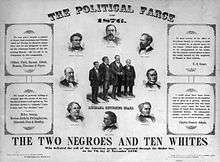
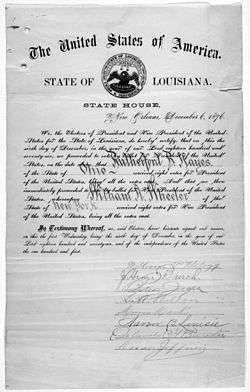

Tilden, who had prosecuted machine politicians in New York and sent legendary political boss William M. Tweed to jail, ran as a reform candidate against the background of the corruption of the Grant administration. Both parties backed civil service reform and an end to Reconstruction. Both sides mounted mud-slinging campaigns, with Democratic attacks on Republican corruption being countered by Republicans raising the Civil War issue, a tactic ridiculed by Democrats who called it "waving the bloody shirt". Republicans chanted, "Not every Democrat was a rebel, but every rebel was a Democrat."
Hayes was a virtual unknown outside his home state of Ohio, where he had served two terms as a Congressman and then two terms as governor. Henry Adams wrote "[Hayes] is a third-rate nonentity whose only recommendations are that he is obnoxious to no one." He had served in the Civil War with distinction as colonel of the 23rd Ohio Regiment and was wounded several times, which made him marketable to veterans. He had later been brevetted as a Major General. Hayes' most important asset was his help to the Republican ticket in carrying the crucial swing state of Ohio. On the other side, newspaperman John D. Defrees described Tilden as "a very nice, prim, little, withered-up, fidgety old bachelor, about one-hundred and twenty-pounds avoirdupois, who never had a genuine impulse for many nor any affection for woman."[11]
The Democratic strategy for victory in the South was highly reliant on paramilitary groups such as the Red Shirts and the White League. Using the strategy of the Mississippi Plan, these groups actively suppressed black and white Republican voter turnouts by disrupting meetings and rallies and even using violence and intimidation.[12][13] They saw themselves as the military wing of the Democratic Party.
Because it was considered improper for a candidate to pursue the presidency actively, neither Tilden nor Hayes actively stumped as part of the campaign, leaving that job to surrogates.
Colorado
Colorado was admitted to the Union as the 38th state on August 1, 1876, but as there was insufficient time or money to organize a presidential election in the new state, Colorado's state legislature selected the state's electors. These electors gave their three votes to Hayes and the Republican Party.[14] This was the last election in which any state chose electors through its state legislature.
Electoral disputes and the Compromise of 1877
In Florida (with 4 electoral votes), Louisiana (with 8), and South Carolina (with 7), reported returns favored Tilden, but election results in each state were marked by electoral fraud and threats of violence against Republican voters. The worst case was in South Carolina, where an impossible 101 percent of all eligible voters in the state had their votes counted.[15] One of the points of contention revolved around the design of ballots. At the time, parties would print ballots or "tickets" to enable voters to support them in the open ballots. To aid illiterate voters the parties would print symbols on the tickets. In this election, many Democratic ballots were printed with the Republican symbol, Abraham Lincoln, on them.[16] The Republican-dominated state electoral commissions subsequently disallowed enough Democratic votes to award their electoral votes to Hayes.
In two southern states, the governor recognized by the United States had signed the Republican certificates. The Democratic certificates from Florida were signed by the state attorney-general and the new Democratic governor. Those from Louisiana were signed by the Democratic gubernatorial candidate, and those from South Carolina by no state official. In the latter state, the Tilden electors simply claimed that they were chosen by the popular vote, and they were rejected by the state election board.[17]
Meanwhile, in Oregon, the vote of a single elector was disputed. The statewide result clearly favored Hayes, but the state's Democratic governor, La Fayette Grover, claimed that one GOP elector, former postmaster John Watts, was ineligible under Article II, Section 1, of the United States Constitution, since he was a "person holding an office of trust or profit under the United States." Grover then substituted a Democratic elector in his place. The two Republican electors dismissed Grover's action and each reported three votes for Hayes, while the Democratic elector, C. A. Cronin, reported one vote for Tilden and two votes for Hayes. The two Republican electors presented a certificate signed by the secretary of state of Oregon. Cronin and the two electors he appointed (Cronin voted for Tilden while his associates voted for Hayes) used a certificate signed by the governor and attested by the secretary of state.[17] Ultimately, all three of Oregon's votes were awarded to Hayes.
Hayes thus had a majority of one in the Electoral College. The Democrats cried fraud. Suppressed excitement pervaded the country. Threats were even muttered that Hayes would never be inaugurated. In Columbus, Ohio, a shot was fired at Governor Hayes' residence as he sat down to dinner. Supporters marched to his home, calling for the "president". Hayes urged the crowd that, "it is impossible, at so early a time, to obtain the result."[18] President Grant quietly strengthened the military force in and around Washington.[17]
The Constitution provides that "the President of the Senate shall, in presence of the Senate and House of Representatives, open all the [electoral] certificates, and the votes shall then be counted." Certain Republicans held that the power to count the votes lay with the President of the Senate, the House and Senate being mere spectators. The Democrats objected to this construction, since the Republican President of the Senate, Thomas W. Ferry, could then count the votes of the disputed states for Hayes. The Democrats insisted that Congress should continue the practice followed since 1865, which was that no vote objected to should be counted except by the concurrence of both houses. The House had a solid Democratic majority; by throwing out the vote of one state, it could elect Tilden.[17]
Facing an unprecedented constitutional crisis, the Congress of the United States passed a law on January 29, 1877 that formed a 15-member Electoral Commission to settle the result. Five members were selected from each house of Congress, and they were joined by five members of the Supreme Court. William M. Evarts served as counsel for the Republican Party. The Compromise of 1877 might have helped the Democrats accept this electoral commission as well.
The majority party in each house named three members and the minority party two. As the Republicans controlled the Senate and the Democrats the House of Representatives, this yielded five Democratic and five Republican members of the Commission. Of the Supreme Court justices, two Republicans and two Democrats were chosen, with the fifth to be selected by these four.
The justices first selected a political independent, Justice David Davis. According to one historian, "[n]o one, perhaps not even Davis himself, knew which presidential candidate he preferred."[18] Just as the Electoral Commission Bill was passing Congress, the legislature of Illinois elected Davis to the Senate. Democrats in the Illinois legislature believed that they had purchased Davis' support by voting for him. However, they had made a miscalculation; instead of staying on the Supreme Court so that he could serve on the Commission, he promptly resigned as a Justice to take his Senate seat.[19] All the remaining available justices were Republicans, so the four justices already selected chose Justice Joseph P. Bradley, who was considered the most impartial remaining member of the court. This selection proved decisive.
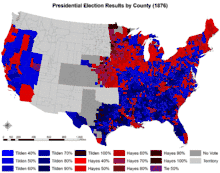
It was drawing perilously near to Inauguration Day. The commission met on January 31. The cases of Florida, Louisiana, Oregon, and South Carolina were in succession submitted to it by Congress. Eminent counsel appeared for each side. There were double sets of returns from every one of the states named.[17]
The commission first decided not to question any returns that were prima facie lawful.[17] Bradley joined the other seven Republican committee members in a series of 8–7 votes that gave all 20 disputed electoral votes to Hayes, giving Hayes a 185–184 electoral vote victory. The commission adjourned on March 2; Hayes privately took the oath of office the next day and was publicly sworn into office on March 5, 1877, Hayes was inaugurated without disturbance.[17]
During intense closed-door meetings, Democratic leaders agreed reluctantly to accept Hayes as president in return for the withdrawal of federal troops from the last two still-occupied Southern states, South Carolina and Louisiana. Republican leaders in return agreed on a number of handouts and entitlements, including Federal subsidies for a transcontinental railroad line through the South. Although some of these promises were not kept, in particular the railroad proposal, it was enough for the time being to avert a dangerous standoff.
The returns accepted by the Commission put Hayes' margin of victory in South Carolina at 889 votes, the second-closest popular vote margin in a decisive state in U.S. history, after the election of 2000, which was decided by 537 votes in Florida (though in 2000, the declared margin of victory in the Electoral College for George W. Bush was five votes, as opposed to Hayes' one vote).
Though it is not possible to conclude definitively what the result would have been if a fair election had been held without the violence and intimidation throughout the South that disenfranchised many African Americans made eligible to vote under the 15th Amendment,[20] in the likeliest fair scenario, Hayes would have won the election (with 189 electoral votes to Tilden's 180) by winning all of the states that he did ultimately carry, plus Mississippi, but minus Florida.[20] In a truly fair election, it seems probable that South Carolina, Mississippi, and Louisiana, which all had majority-black populations, would have gone Republican, while Florida, with a majority white population, would have likely gone to Tilden.[20] It is therefore likely that Hayes would have won appreciably more of the popular vote in a fair election, perhaps even a plurality or majority.[20]
Upon his defeat, Tilden said, "I can retire to public life with the consciousness that I shall receive from posterity the credit of having been elected to the highest position in the gift of the people, without any of the cares and responsibilities of the office."
Congress would eventually enact the Electoral Count Act in 1887 to provide more detailed rules for the counting of electoral votes, especially in cases where multiple slates of electors have been received from a single state.
Results
According to the Commission's rulings, of the 2,249 counties and independent cities making returns, Tilden won in 1,301 (57.85%) while Hayes carried only 947 (42.11%). One county (0.04%) in Nevada split evenly between Tilden and Hayes.
While the Greenback ticket did not have a major impact on the election's outcome, attracting slightly under one percent of the popular vote, Cooper nonetheless had the strongest performance of any third-party presidential candidate since John Bell in 1860. The Greenbacks' best showings were in Kansas, where Cooper earned just over six percent of the vote, and Indiana, where he earned 17,207 votes, far exceeding Tilden's roughly 5,500-vote margin of victory over Hayes in that state.
The election of 1876 was the last one held before the end of the Reconstruction era, which sought to protect the rights of African Americans in the South who usually voted for Republican presidential candidates. No antebellum slave state would be carried by a Republican again until the 1896 realignment that saw William McKinley carry Delaware, Maryland, West Virginia and Kentucky. No Republican presidential candidate until Warren G. Harding in 1920 would carry any states that seceded and joined the Confederacy; that year he carried Tennessee, which never experienced a long period of occupation by Federal troops and was completely "reconstructed" well before the first presidential election of the Reconstruction period (1868). None of the Southern states that experienced long periods of occupation by Federal troops was carried by a Republican again until Herbert Hoover in 1928 (when he won Texas, Florida, North Carolina, and Virginia). This proved the last election in which the Republican candidate won Louisiana until 1956, when Dwight D. Eisenhower carried it, and the last in which the Republican candidate won South Carolina until 1964, when Barry Goldwater did. The next time those two states voted against the Democrats was when they supported the "Dixiecrat" candidate Strom Thurmond in 1948.
Although 1876 marked the last competitive two-party election in the South before Democratic dominance of the South through 1948 and of the border states through 1896, it was also the last election (as of 2017) in which the Democrats won the pro-Union counties of Mitchell in North Carolina,[21] Wayne and Henderson in Tennessee, and Lewis County, Kentucky.[22] Hayes is also the most recent Republican president elected without carrying Indiana.
| Presidential candidate | Party | Home state | Popular vote[23] | Electoral vote[24] |
Running mate | |||
|---|---|---|---|---|---|---|---|---|
| Count | Percentage | Vice-presidential candidate | Home state | Electoral vote[25] | ||||
| Rutherford B. Hayes | Republican | Ohio | 4,034,142 | 47.92% | 185 | William A. Wheeler | New York | 185 |
| Samuel J. Tilden | Democratic | New York | 4,286,808 | 50.92% | 184 | Thomas A. Hendricks | Indiana | 184 |
| Peter Cooper | Greenback | New York | 83,726 | 0.99% | 0 | Samuel Fenton Cary | Ohio | 0 |
| Green Clay Smith | Prohibition | Washington, D.C. | 6,945 | 0.08% | 0 | Gideon T. Stewart | Ohio | 0 |
| James Walker | American National Party | Illinois | 463 | 0.01% | 0 | Donald Kirkpatrick | New York | 0 |
| Other | 6,575 | 0.08% | — | Other | — | |||
| Total | 8,418,659 | 100% | 369 | 369 | ||||
| Needed to win | 185 | 185 | ||||||
Geography of results
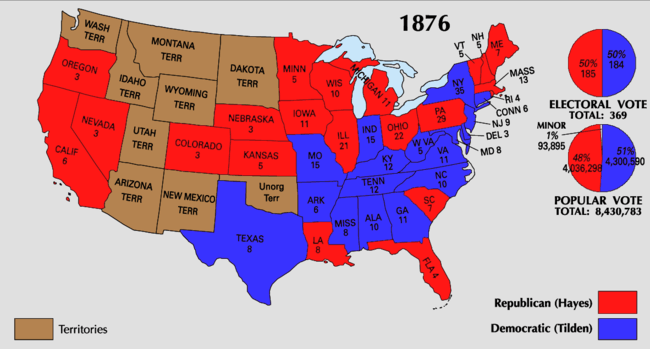
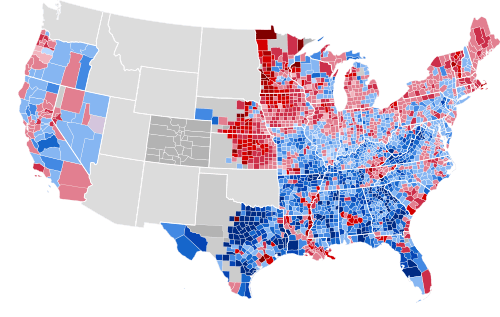 Results by county, shaded according to winning candidate's percentage of the vote
Results by county, shaded according to winning candidate's percentage of the vote
Cartographic gallery
 Map of presidential election results by county
Map of presidential election results by county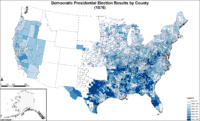 Map of Democratic presidential election results by county
Map of Democratic presidential election results by county Map of Republican presidential election results by county
Map of Republican presidential election results by county Map of "other" presidential election results by county
Map of "other" presidential election results by county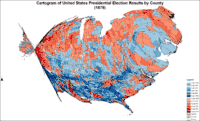 Cartogram of presidential election results by county
Cartogram of presidential election results by county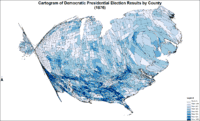 Cartogram of Democratic presidential election results by county
Cartogram of Democratic presidential election results by county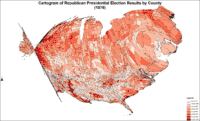 Cartogram of Republican presidential election results by county
Cartogram of Republican presidential election results by county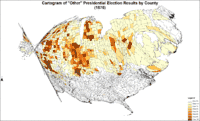 Cartogram of "other" presidential election results by county
Cartogram of "other" presidential election results by county
Results by state
Source: Data from Walter Dean Burnham, Presidential ballots, 1836–1892 (Johns Hopkins University Press, 1955) pp 247–57.[26]
| States won by Tilden/Hendricks |
| States won by Hayes/Wheeler |
| Samuel J. Tilden Democratic |
Rutherford B. Hayes Republican |
Peter Cooper Greenback |
Green Smith Prohibition |
Margin | State Total | ||||||||||||
|---|---|---|---|---|---|---|---|---|---|---|---|---|---|---|---|---|---|
| State | electoral votes |
# | % | electoral votes |
# | % | electoral votes |
# | % | electoral votes |
# | % | electoral votes |
# | % | electoral votes |
|
| Alabama | 10 | 102,989 | 59.98 | 10 | 68,708 | 40.02 | – | – | – | – | – | – | – | −34,281 | −19.97 | 171,699 | AL |
| Arkansas | 6 | 58,086 | 59.92 | 6 | 38,649 | 39.87 | – | 211 | 0.22 | – | – | – | – | −19,437 | −20.05 | 96,946 | AR |
| California | 6 | 76,460 | 49.08 | – | 79,258 | 50.88 | 6 | 47 | 0.03 | – | – | – | – | 2,798 | 1.80 | 155,784 | CA |
| Colorado* | 3 | – | – | – | – | – | 3 | – | – | – | – | – | – | – | – | – | CO |
| Connecticut | 6 | 61,927 | 50.70 | 6 | 59,033 | 48.33 | – | 774 | 0.63 | – | 374 | 0.31 | – | −2,894 | −2.37 | 122,134 | CT |
| Delaware | 3 | 13,381 | 55.45 | 3 | 10,752 | 44.55 | – | – | – | – | – | – | – | −2,629 | −10.89 | 24,133 | DE |
| Florida | 4 | 22,927 | 49.01 | – | 23,849 | 50.99 | 4 | – | – | – | – | – | – | 922 | 1.97 | 46,776 | FL |
| Georgia | 11 | 130,157 | 72.03 | 11 | 50,533 | 27.97 | – | – | – | – | – | – | – | −79,624 | −44.07 | 180,690 | GA |
| Illinois | 21 | 258,611 | 46.66 | – | 278,232 | 50.20 | 21 | 17,207 | 3.10 | – | – | – | – | 19,621 | 3.54 | 554,227 | IL |
| Indiana | 15 | 213,526 | 48.65 | 15 | 208,011 | 47.39 | – | 17,233 | 3.93 | – | 141 | 0.03 | – | −5,515 | −1.26 | 438,911 | IN |
| Iowa | 11 | 112,121 | 38.28 | – | 171,326 | 58.50 | 11 | 9,431 | 3.22 | – | – | – | – | 59,205 | 20.21 | 292,878 | IA |
| Kansas | 5 | 37,902 | 30.53 | – | 78,324 | 63.10 | 5 | 7,770 | 6.26 | – | 110 | 0.09 | – | 40,422 | 32.56 | 124,134 | KS |
| Kentucky | 12 | 160,060 | 61.41 | 12 | 97,568 | 37.44 | – | – | – | – | – | – | – | −62,492 | −23.98 | 260,626 | KY |
| Louisiana | 8 | 70,508 | 48.35 | – | 75,315 | 51.65 | 8 | – | – | – | – | – | – | 4,807 | 3.30 | 145,823 | LA |
| Maine | 7 | 49,917 | 42.65 | – | 66,300 | 56.64 | 7 | – | – | – | – | – | – | 16,383 | 14.00 | 117,045 | ME |
| Maryland | 8 | 91,779 | 56.05 | 8 | 71,980 | 43.95 | – | – | – | – | – | – | – | −19,799 | −12.09 | 163,759 | MD |
| Massachusetts | 13 | 108,777 | 41.90 | – | 150,064 | 57.80 | 13 | – | – | – | – | – | – | 41,287 | 15.90 | 259,620 | MA |
| Michigan | 11 | 141,685 | 44.49 | – | 166,901 | 52.41 | 11 | 9,023 | 2.83 | – | 766 | 0.24 | – | 25,216 | 7.92 | 318,450 | MI |
| Minnesota | 5 | 48,587 | 39.16 | – | 72,955 | 58.80 | 5 | 2,389 | 1.93 | – | 144 | 0.12 | – | 24,368 | 19.64 | 124,075 | MN |
| Mississippi | 8 | 112,173 | 68.08 | 8 | 52,603 | 31.92 | – | – | – | – | – | – | – | −59,570 | −36.15 | 164,776 | MS |
| Missouri | 15 | 202,086 | 57.64 | 15 | 145,027 | 41.36 | – | 3,497 | 1.00 | – | – | – | – | −57,059 | −16.27 | 350,610 | MO |
| Nebraska | 3 | 17,413 | 35.30 | – | 31,915 | 64.70 | 3 | – | – | – | – | – | – | 14,502 | 29.40 | 49,328 | NE |
| Nevada | 3 | 9,308 | 47.27 | – | 10,383 | 52.73 | 3 | – | – | – | – | – | – | 1,075 | 5.46 | 19,691 | NV |
| New Hampshire | 5 | 38,510 | 48.05 | – | 41,540 | 51.83 | 5 | – | – | – | – | – | – | 3,030 | 3.78 | 80,141 | NH |
| New Jersey | 9 | 115,962 | 52.66 | 9 | 103,517 | 47.01 | – | 714 | 0.32 | – | – | – | – | −12,445 | −5.65 | 220,193 | NJ |
| New York | 35 | 521,949 | 51.40 | 35 | 489,207 | 48.17 | – | 1,978 | 0.19 | – | 2,369 | 0.23 | – | −32,742 | −3.22 | 1,015,503 | NY |
| North Carolina | 10 | 125,427 | 53.62 | 10 | 108,484 | 46.38 | – | – | – | – | – | – | – | −16,943 | −7.24 | 233,911 | NC |
| Ohio | 22 | 323,182 | 49.07 | – | 330,698 | 50.21 | 22 | 3,057 | 0.46 | – | 1,636 | 0.25 | – | 7,516 | 1.14 | 658,649 | OH |
| Oregon | 3 | 14,157 | 47.38 | – | 15,214 | 50.92 | 3 | 510 | 1.71 | – | – | – | – | 1,057 | 3.54 | 29,881 | OR |
| Pennsylvania | 29 | 366,204 | 48.25 | – | 384,184 | 50.62 | 29 | 7,204 | 0.95 | – | 1,318 | 0.17 | – | 17,980 | 2.37 | 758,993 | PA |
| Rhode Island | 4 | 10,712 | 40.23 | – | 15,787 | 59.29 | 4 | 68 | 0.26 | – | 60 | 0.23 | – | 5,075 | 19.06 | 26,627 | RI |
| South Carolina | 7 | 90,897 | 49.76 | – | 91,786 | 50.24 | 7 | – | – | – | – | – | – | 889 | 0.49 | 182,683 | SC |
| Tennessee | 12 | 133,177 | 59.79 | 12 | 89,566 | 40.21 | – | – | – | – | – | – | – | −43,611 | −19.58 | 222,743 | TN |
| Texas | 8 | 104,755 | 70.04 | 8 | 44,800 | 29.96 | – | – | – | – | – | – | – | −59,955 | −40.09 | 149,555 | TX |
| Vermont | 5 | 20,254 | 31.38 | – | 44,091 | 68.30 | 5 | – | – | – | – | – | – | 23,837 | 36.93 | 64,553 | VT |
| Virginia | 11 | 140,770 | 59.58 | 11 | 95,518 | 40.42 | – | – | – | – | – | – | – | −45,252 | −19.15 | 236,288 | VA |
| West Virginia | 5 | 56,546 | 56.75 | 5 | 41,997 | 42.15 | – | 1,104 | 1.11 | – | – | – | – | −14,549 | −14.60 | 99,647 | WV |
| Wisconsin | 10 | 123,926 | 48.19 | – | 130,067 | 50.57 | 10 | 1,509 | 0.59 | – | 27 | 0.01 | – | 6,141 | 2.39 | 257,177 | WI |
| TOTALS: | 369 | 4,286,808 | 50.92 | 184 | 4,034,142 | 47.92 | 185 | 83,726 | 0.99 | – | 6,945 | 0.08 | – | -252,666 | -3.00 | 8,418,659 | US |
Close states
Margin of victory less than 5% (171 electoral votes):
- South Carolina, 0.49% (tipping point state)
- Ohio, 1.14%
- Indiana, 1.26%
- California, 1.80%
- Florida, 1.97%
- Pennsylvania, 2.37%
- Connecticut, 2.37%
- Wisconsin, 2.39%
- New York, 3.22%
- Louisiana, 3.30%
- Oregon, 3.54%
- Illinois, 3.54%
- New Hampshire, 3.78%
Margin of victory between 5% and 10% (33 electoral votes):
- Nevada, 5.46%
- New Jersey, 5.65%
- North Carolina, 7.24%
- Michigan, 7.92%
Cultural references
The presidential election of 1876 is a major theme of Gore Vidal's novel 1876.
See also
- American election campaigns in the 19th century
- History of the United States (1865–1918)
- Inauguration of Rutherford B. Hayes
- 1876 United States House of Representatives elections
- 1876 and 1877 United States Senate elections
- Third Party System
References
- Between 1828–1928: "Voter Turnout in Presidential Elections: 1828 – 2008". The American Presidency Project. University of California, Santa Barbara. Retrieved November 9, 2012.
- Keith Ian Polakoff, The Politics of Inertia: The Election of 1876 and the End of Reconstruction (1973).
- Between 1932 and 2008: "Table 397. Participation in Elections for President and U.S. Representatives: 1932 to 2010" (PDF). U.S. Census Bureau, Statistical Abstract of the United States: 2012. U.S. Census Bureau. Archived from the original (PDF) on October 24, 2012. Retrieved February 7, 2013.
- Presidential election of 1876
- "Was Grant a candidate?". Archived from the original on February 10, 2018. Retrieved June 30, 2014.
- https://archive.org/stream/proceedingsrepu00nelsgoog#page/n112/mode/2up
- DeGregorio, William (1997). The Complete Book of U.S. Presidents. New York: Gramercy. ISBN 0-517-18353-6.
- They Also Ran
- Smith, Joseph Patterson (1898). History of the Republican party in Ohio. Volume I. Chicago: The Lewis Publishing Company. p. 352. Retrieved May 19, 2018.
- "US President – American National Convention Race – Jun 08, 1875". Our Campaigns. June 21, 2010. Retrieved February 17, 2014.
- Holt, Michael F., By One Vote, University Press of Kansas, 2008, pg. 129
- The violent origin of the term bulldoze as a means of intimidation came from this election. To "bulldose" or "bulldoze" meant to intimidate by violent means, sometimes by whipping or flogging. 'Bulldozing' was used by some groups of Republicans and Democrats around the country to intimidate political opponents, and was used to intimidate African Americans in the Southern United States, particularly in Louisiana.
- Kelly, John. "What in the Word?! The racist roots of 'bulldozer'". Oxford Dictionaries. Oxford University Press. Retrieved October 21, 2018.
- Kleinfeld, N. R. (November 12, 2000). "COUNTING THE VOTE: THE HISTORY; President Tilden? No, but Almost, in Another Vote That Dragged On". The New York Times.
- Holt, Michael F, By One Vote, University Press of Kansas, 2008, pg. 167, pg. 255
- "Flashback to 1876: History repeats itself". BBC News. London. December 12, 2000. Retrieved November 28, 2006.
- Andrews, E. Benjamin (1912). History of the United States. Charles Scribner's Sons.
- Morris, Roy, Jr. (2003). Fraud of the Century: Rutherford B. Hayes, Samuel Tilden and the Stolen Election of 1876. New York: Simon and Schuster, pp. 168, 239. ISBN 978-0-7432-5552-3
- "Hayes v. Tilden: The Electoral College Controversy of 1876–1877." Archived February 20, 2006, at the Wayback Machine HarpWeek
- Who Won the 1876 Election? Issue 9 of Buttons and Ballots, in Spring 1997.
- The Political Graveyard; Mitchell County, North Carolina
- Sullivan, Robert David; ‘How the Red and Blue Map Evolved Over the Past Century’; America Magazine in The National Catholic Review; June 29, 2016
- Leip, David. "1876 Presidential Election Results". Dave Leip's Atlas of U.S. Presidential Elections. Retrieved July 27, 2005.
- "Electoral College Box Scores 1789–1996". National Archives and Records Administration. Retrieved July 31, 2005.
- "Electoral College Box Scores 1789–1996". National Archives and Records Administration. Retrieved July 31, 2005.
- "1876 Presidential General Election Data – National". Retrieved May 7, 2013.
Sources and further reading
- Appleton's Annual Cyclopedia ...for 1876 (1885), comprehensive world coverage
- John Bigelow, Author, Edited by, Nikki Oldaker, The Life of Samuel J. Tilden.] (2009 Revised edition-retype-set-new photos). 444 pages, ISBN 978-0-9786698-1-2 original 1895 edition
- Holt, Michael F. By One Vote: The Disputed Presidential Election of 1876. (2008). 304 pages, ISBN 978-0-7006-1608-4
- Flick, Alexander C. (1939). Samuel J. Tilden — A Study In Political Sagacity.
- Haworth, Paul Leland (1906). The Hayes-Tilden Disputed Presidential Election of 1876. Burrows Brothers Company.
Campaign Text Book.
- Hoogenboom, Ari (1995). Rutherford B. Hayes: Warrior and President. ISBN 0-7006-0641-6.
- Morris, Roy, Jr. (2004). Fraud Of The Century: Rutherford B. Hayes, Samuel Tilden And The Stolen Election Of 1876.
- Polakoff, Keith Ian (1973). The Politics of Inertia: The Election of 1876 and the End of Reconstruction.
- Rehnquist, William H. (2004). The Centennial Crisis: The Disputed Election of 1876. Knopf Publishing Group. ISBN 0-375-41387-1., popular account
- Summers, Mark Wahlgren.The Press Gang: Newspapers and Politics, 1865-1878 (1994)
- Summers, Mark Wahlgren. The Era of Good Stealings (1993), covers corruption 1868-1877
- Richard White, "Corporations, Corruption, and the Modern Lobby: A Gilded Age Story of the West and the South in Washington, D.C." Southern Spaces, April 16, 2009
- Woodward, C. Vann (1951). Reunion and Reaction: The Compromise of 1877 and the End of Reconstruction.
Primary sources
- Democratic National Committee (1876). The Campaign Text Book: Why the People Want a Change. The Republican Party Reviewed…. p. 1.
Colfax massacre.
- Chester, Edward W A guide to political platforms (1977) online
- Porter, Kirk H. and Donald Bruce Johnson, eds. National party platforms, 1840-1964 (1965) online 1840-1956
External links
| Wikimedia Commons has media related to United States presidential election, 1876. |
- Hayes Presidential Library with essays by historians
- Presidential Election of 1876: A Resource Guide from the Library of Congress
- Rutherford B. Hayes On The Election of 1876: Original Letter Shapell Manuscript Foundation
- 1876 popular vote by counties
- Hayes vs. Tilden: The Electoral College Controversy of 1876–1877
- How close was the 1876 election? at the Wayback Machine (archived August 25, 2012) — Michael Sheppard, Massachusetts Institute of Technology
- Election of 1876 in Counting the Votes


